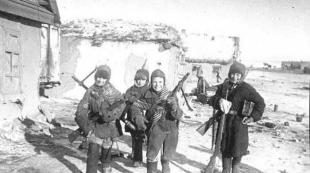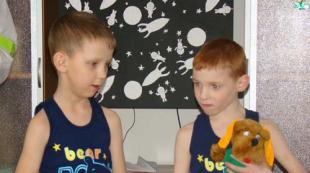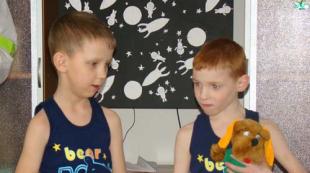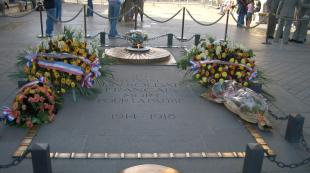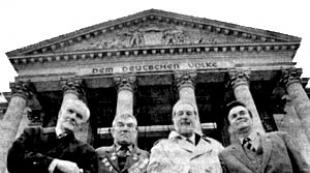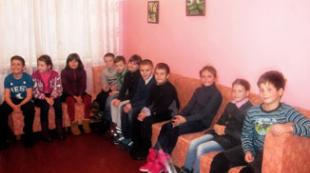Theories of localization of functions in the cerebral cortex. Morphological foundations of dynamic localization of functions in the cerebral cortex (centers of the cerebral cortex). Self-study assignments
The cerebral cortex is the material basis of human mental activity. The bark is a gray matter with a thickness of 1.5 to 5 mm, contains 14 billion nerve cells and has a six-layer structure. The bark is a huge nuclear center, a core spread over the surface of the hemispheres.
For more than 130 years there has been a dispute - whether there are centers in the bark or not and to what extent they affect the "supervised" functions: 1. Whether these centers are literally responsible for everything (the center of tourism, love of painting, theater, etc.), or their influence is less detailed. 2. The bark is one solid screen center responsible for all functions.
Obviously, the truth, as always, is somewhere in between.
The founder of a detailed study of the cellular composition of the cortex was a Russian scientist, Kiev resident Vladimir Alekseevich Betz. In 1874 he published the result of his research using his own method of serial sections and carmine staining. Betz revealed a different structure of the cortex in different parts of it and developed a map of the cytoarchitectonics of the cortex. Subsequently, other maps were created: Brodmann with 52 cytoarchitectonic fields, Vogt with 150 myeloarchitectonic fields, etc. Research is currently continuing at the Brain Institute in Moscow and in other countries.
The concepts of the localization of functions in the cerebral cortex are of great practical importance for solving problems of the topic of lesions in the cerebral hemispheres. Everyday clinical experience shows that there are certain patterns of dependence of functional disorders on the location of the pathological focus. Based on this, the clinician solves the problems of topical diagnostics. However, this is the case with simple functions: movement and sensitivity. The functions are more complex, phylogenetically young, and cannot be narrowly localized; very extensive areas of the cortex, even the entire cortex, are involved in the implementation of complex functions.
The works of V.A. Betz were carefully studied by I.P. Pavlov. Taking into account these data, Ivan Petrovich Pavlov created the foundations of a new and progressive doctrine of the localization of functions in the brain. Pavlov considered the cerebral cortex as a set of cortical ends of the analyzers. Pavlov created the doctrine of analyzers. According to Pavlov, the analyzer is a nervous mechanism that analyzes the phenomena of the external and internal world by decomposing a complex complex of stimuli into separate elements. It begins with the perceiving apparatus and ends in the brain, that is, the analyzer turns on the receptor apparatus, the conductor nerve impulses and the cortical center.
Pavlov proved that cortical end of the analyzer- this is not a strictly delineated area. It has a core and scattered elements. Core- the place of concentration of nerve cells, where the highest analysis, synthesis and integration take place. On its periphery, in the scattered elements, simple analysis and synthesis takes place. The areas of scattered elements of adjacent analyzers overlap each other (Fig.).
According to Pavlov, the work of the second signaling system is inextricably linked with the functions of all analyzers; therefore, it is impossible to imagine the localization of the complex functions of the second signaling system in limited cortical fields. Pavlov laid the foundations of the doctrine of the dynamic localization of functions in the cortex. The concept of dynamic localization of functions in the cortex suggests the possibility of using the same cortical structures in various combinations to serve various complex cortical functions. So, associative pathways unite analyzers, contributing to the higher synthetic activity of the cerebral cortex. Scientists today know that irritation is transformed into excitement, which is transmitted to the cortical end of the analyzer. Another thing is not clear - where and how is excitement transformed into sensation? What structures are responsible for this? So, when the visual field is irritated in the area of the furrow, "simple" hallucinations appear in the form of light or color spots, sparks, shadows. Irritation of the outer surface of the occipital lobe gives "complex" hallucinations in the form of figures, moving objects.
In the motor zone of the cortex, cells were found that give a discharge of impulses to visual, auditory, and skin irritations, and in the visual zone of the cortex, neurons were found that respond with electrical discharges to tactile, sound, vestibular and olfactory stimuli. In addition, neurons were found that respond not only to "their" stimulus, as they say now, the stimulus of their modality, their quality, but also to one or two strangers. They were called polysensory neurons.
This section of the anatomy of the NN is divided into the following subcategories
Currently, the division of the cortex into sensory, motor and associative (nonspecific) zones (areas) is accepted.
Motor. Allocate primary and secondary motor zones. The primary contains neurons responsible for the movement of the muscles of the face, trunk and limbs. Irritation of the primary motor zone causes muscle contractions on the opposite side of the body. When this zone is affected, the ability to finely coordinated movements, especially with the fingers, is lost. The secondary motor zone is associated with the planning and coordination of voluntary movements. Here the readiness potential is regenerated approximately 1 second before the start of the movement.
The sensory zone consists of a primary and a secondary. In the primary sensory zone, a spatial topographic representation of body parts is formed. The secondary sensory zone consists of neurons responsible for the action of several stimuli. Sensory zones are localized mainly in the parietal lobe of the GM. There is a projection of skin sensitivity, pain, temperature, tactile receptors. The occipital lobe contains the primary visual area.
Associative. Includes thalotemporal, talolobic and taloformal lobes.
Sensory area of the cerebral cortex.
Sensory zones- These are the functional areas of the cerebral cortex that receive sensory information from most of the body's receptors through the ascending nerve pathways. They occupy separate areas of the cortex associated with certain types of sensations. The sizes of these zones correlate with the number of receptors in the corresponding sensory system.
Primary sensory zones and primary motor zones (projection zones);
Secondary sensory zones and secondary motor zones (associative unimodal zones);
Tertiary zones (associative multi-modal zones);
Primary sensory and motor areas occupy less than 10% of the surface of the cerebral cortex and provide the simplest sensory and motor functions.
Somatosensory cortex- an area of the cerebral cortex that is responsible for the regulation of certain sensory systems... The first somatosensory zone is located on the postcentral gyrus directly behind the deep central sulcus. The second somatosensory zone is located on the upper wall of the lateral groove separating the parietal and temporal lobes. Thermoreceptive and nociceptive (pain) neurons were found in these zones. First zone(I) is fairly well studied. Almost all areas of the body surface are represented here. As a result of systematic studies, a fairly accurate picture of the body representations in this area of the cerebral cortex has been obtained. In literary and scientific sources, such a representation has received the name "somatosensory homunculus" (for details, see unit 3). The somatosensory cortex of these zones, taking into account the six-layer structure, is organized in the form of functional units - columns of neurons (diameter 0.2-0.5 mm), which are endowed with two specific properties: limited horizontal spread of afferent neurons and vertical orientation of pyramidal cell dendrites. Neurons of one column are excited by receptors of only one type, i.e. specific receptor endings. Processing of information in columns and between them is carried out hierarchically. The efferent connections of the first zone transmit the processed information to the motor cortex (regulation of movements by feedback is provided), the parietal-associative zone (integration of visual and tactile information is provided) and to the thalamus, nuclei of the posterior column, the spinal cord (efferent regulation of the flow of afferent information is provided). The first zone functionally provides accurate tactile discrimination and conscious perception of stimuli on the body surface. Second zone(Ii) less studied and it takes up much less space. Phylogenetically, the second zone is older than the first and is involved in almost all somatosensory processes. The receptive fields of the neural columns of the second zone are located on both sides of the body, and their projections are symmetrical. This zone coordinates the actions of sensory and motor information, for example, when touching objects with two hands.
Of the brain
There are projection zones in the cerebral cortex.
Primary projection area- occupies the central part of the brain analyzer nucleus. This is a collection of the most differentiated neurons, in which the highest analysis and synthesis of information takes place, clear and complex sensations arise there. These neurons are approached by impulses along a specific pathway for transmitting impulses in the cerebral cortex (spinothalamic pathway).
Secondary projection area
- is located around the primary, is part of the nucleus of the cerebral section of the analyzer and receives impulses from the primary projection zone. Provides complex perception. When this zone is damaged, a complex dysfunction occurs.
Tertiary projection area
- associative - these are polymodal neurons scattered throughout the cerebral cortex. They receive impulses from the associative nuclei of the thalamus and converge impulses of different modality. Provides connections between various analyzers and plays a role in the formation of conditioned reflexes.
Cerebral cortex functions:
makes perfect the relationship between organs and tissues inside the body;
provides a complex relationship between the body and the external environment;
provides the processes of thinking and consciousness;
is a substrate of higher nervous activity.
Development interconnection fine motor skills cognitive sphere
A.R. Luria (1962) believed that higher mental functions as complex functional systems cannot be localized in narrow zones of the cerebral cortex or in isolated cell groups, but should cover complex systems of jointly working zones, each of which contributes to the implementation of complex mental processes and which can be located in completely different, sometimes far-apart areas of the brain.
Based on the achievements of domestic materialistic physiology (on the works of I.M.Sechenov, I.P. Pavlov, P.K. Anokhin, N.A. Bernstein,
N.P.Bekhtereva, E. H. Sokolov and other physiologists), mental functions are considered as formations that have a complex reflex basis, determined by external stimuli, or as complex forms of adaptive activity of the body, aimed at solving certain psychological problems.
L.S. Vygotsky formulated a rule according to which the defeat of a certain area of the brain in early childhood systemically affects the higher zones of the cortex, built on top of them, while the defeat of the same area in adulthood affects the lower zones of the cortex, which now depend on them. is one of the fundamental provisions introduced into the doctrine of the dynamic localization of the higher mental functions of Russian psychological science. As an illustration, let us point out that the defeat of the secondary parts of the visual cortex in early childhood can lead to systemic underdevelopment of the higher processes associated with visual thinking, while the defeat of the same zones in adulthood can cause only partial defects in visual analysis and synthesis, leaving more complex forms of thinking that have already been formed are preserved.
All data (both anatomical, physiological, and clinical) testify to the leading role of the cerebral cortex in the cerebral organization of mental processes. The cerebral cortex (and above all, the new cortex) is the most differentiated in structure and function of the brain. At present, the point of view has become generally accepted about the important and specific role of not only cortical, but also subcortical structures in mental activity with the leading participation of the cerebral cortex.
An analytical review of literature data shows that there is an ontogenetic interdependence of the development of fine motor skills and speech
(V.I.Beltyukov; MM. Koltsova; L.A. Kukuev; L.A. Novikov and others) and that hand movements historically, in the course of human development, had a significant impact on the formation of speech function. Comparing the results of experimental studies indicating a close relationship between the function of the hand and speech, relying on the data of electrophysiological experiments, M.M. Koltsova came to the conclusion that the morphological and functional formation of speech areas occurs under the influence of kinesthetic impulses from the muscles of the arms. The author specifically emphasizes that the influence of impulses from the muscles of the hand is most noticeable in childhood, when the speech motor area is being formed. Systematic exercises for training finger movements have a stimulating effect on the development of speech and are, according to M.M. Koltsova, "a powerful means of increasing the efficiency of the cerebral cortex."
Pointing to the importance of studying and improving the motor sphere in children in need of special correctional education, Vygotsky wrote that, being relatively independent, independent of higher intellectual functions and easily exercised, the motor sphere provides a richest opportunity for compensating for an intellectual defect. The formation of higher types of human conscious activity is always carried out with the support of a number of external auxiliary tools or means.
Many domestic researchers pay attention to the need and pedagogical significance of work on the correction of motor skills in children in the complex of correctional and developmental measures (L.Z. Arutyunyan (Andronova); R.D.Babenkov; L.I.Belyakova).
With the help of electrophysiological methods, it has been established that in the cortex it is possible to distinguish areas of three types in accordance with the functions that the cells in them perform: sensory zones of the cerebral cortex, associative zones of the cerebral cortex and motor zones of the cerebral cortex. The interconnections between these areas allow the cerebral cortex to control and coordinate all voluntary and some involuntary forms of activity, including such higher functions as memory, learning, consciousness and personality traits.
Thus, we can conclude that palm massage, finger gymnastics and work with a massage ball activate the parts of the brain that are responsible for thinking, memory, attention and speech (human cognitive sphere).
Based on materials from the book by Bachina O.V., Korobova N.F. Finger gymnastics with apparatus (Note 2).
Exercises with a massage ball for 5-7 repetitions:
The ball is held between the palms. The ball is rolled first between the palms, then along the palms towards the fingertips.
The ball is held between the palms. Squeeze and unclench the ball in the palms.
The ball is held between the palms. The ball is rolled clockwise, then counterclockwise.
The ball is between the palms. "Making a snowball"
Throwing the ball from hand to hand,
Twisting the ball around the hands alternately.
From personal experience, I can say that if the exercises are alternated, then the children do them with great pleasure.
Literature
A.R. Luria. Fundamentals of Neuropsychology. - M .: Academia, 2002.
Bachina O.V., Korobova N.F. Finger gymnastics with objects. Determination of the leading hand and the development of writing skills in children 6-8 years old: A practical guide for teachers and parents. - M .: ARKTI, 2006.
Vygotsky L.S. Thinking and speaking. Ed. 5, rev. - M .: Labyrinth, 1999.
Krol V. Human psychophysiology. - SPb .: Peter, 2003.
Mukhina V.S. Age-related psychology: Phenomenology of Development, Childhood, Adolescence: Textbook for Stud. universities. - 4th ed., Stereotype. - M .: Publishing Center "Academy", 1999.
Chomskaya E. D. Kh. Neuropsychology: 4th edition. - SPb .: Peter, 2005.
http://dic.academic.ru/dic.nsf/ruwiki/980358
NOTES
Note 1
Note 2
Finger gymnastics with a pen or pencil

This question is extremely important in theory and especially in practice. Hippocrates already knew that brain injuries lead to paralysis and seizures in the opposite half of the body, and sometimes are accompanied by loss of speech.
In 1861, the French anatomist and surgeon Broca, at an autopsy of the corpses of several patients suffering from speech disorders in the form of motor aphasia, discovered profound changes in the pars opercularis of the third frontal gyrus of the left hemisphere or in the white matter under this area of the cortex. Based on his observations, Broca established a motor speech center in the cerebral cortex, which was later named after him.
The English neuropathologist Jackson (1864) also spoke in favor of the functional specialization of individual sections of the hemispheres on the basis of clinical data. Somewhat later (1870), the German researchers Fritsch and Gitzig proved the existence of special areas in the dog's cerebral cortex, the irritation of which with a weak electric current is accompanied by a contraction of individual muscle groups. This discovery triggered a large number of experiments, which basically confirmed the existence of certain motor and sensory regions in the cerebral cortex of higher animals and humans.
On the issue of localization (representation) of the function in the cerebral cortex, two diametrically opposite points of view competed with each other: localizationists and antilocalizationists (equipotentialists).
Localizationists were supporters of the narrow localization of various functions, both simple and complex.
The anti-localizationists took a completely different view. They denied any localization of functions in the brain. The whole bark was equal and homogeneous for them. All of its structures, they believed, have the same capabilities for the implementation of various functions (equipotential).
The problem of localization can be correctly resolved only with a dialectical approach to it, which takes into account both the integral activity of the entire brain and the different physiological significance of its individual parts. It is in this way that I.P. Pavlov approached the problem of localization. Numerous experiments of I.P. Pavlov and his co-workers with the extirpation of certain parts of the brain speak convincingly in favor of the localization of functions in the cortex. Resection of the occipital lobes of the cerebral hemispheres (centers of vision) in a dog causes enormous damage to the conditioned reflexes developed in it to visual signals and leaves all conditioned reflexes to sound, tactile, olfactory and other stimuli intact. On the contrary, resection of the temporal lobes (hearing centers) leads to the disappearance of conditioned reflexes to sound signals and does not affect the reflexes associated with optical signals, etc. The latest electroencephalography data also speak against equipotentialism, in favor of the representation of the function in certain zones of the cerebral hemispheres. ... Irritation of a specific area of the body leads to the appearance of reactive (evoked) potentials in the cortex in the "center" of this area.
IP Pavlov was a staunch supporter of the localization of functions in the cerebral cortex, but only relative and dynamic localization. The relativity of localization is manifested in the fact that each part of the cerebral cortex, being a carrier of a certain special function, the "center" of this function, responsible for it, participates in many other functions of the cortex, but no longer as a main link, not in the role of a "center" ”, But on a par with many other areas.
The functional plasticity of the cortex, its ability to restore the lost function by establishing new combinations speaks not only of the relativity of the localization of functions, but also of its dynamism.
At the heart of any more or less complex function is the coordinated activity of many areas of the cerebral cortex, but each of these areas participates in this function in its own way.
At the heart of modern ideas about "systemic localization of functions" is the teaching of IP Pavlov about the dynamic stereotype. Thus, the higher mental functions (speech, writing, reading, counting, gnosis, praxis) have a complex organization. They are never carried out by some isolated centers, but are always processes "located in a complex system of zones of the cerebral cortex" (AR Luria, 1969). These "functional systems" are mobile; in other words, the system of means by which this or that problem can be solved changes, which, of course, does not reduce the value for them of the well-studied "fixed" cortical zones of Broca, Wernicke, and others.
The centers of the cerebral hemispheres of a person are divided into symmetrical, presented in both hemispheres, and asymmetric, available only in one hemisphere. The latter include the centers of speech and functions associated with the act of speech (writing, reading, etc.), existing only in one hemisphere: in the left - in right-handers, in the right - in left-handers.
Modern ideas about the structural and functional organization of the cerebral cortex are based on the classical Pavlovian concept of analyzers, refined and supplemented by subsequent research. There are three types of cortical fields (GI Polyakov, 1969). The primary fields (the nuclei of the analyzers) correspond to the architectonic zones of the cortex, in which the sensory pathways (projection zones) end. Secondary fields (peripheral parts of the analyzer nuclei) are located around the primary fields. These zones are indirectly associated with receptors, in them a more detailed processing of incoming signals takes place. Tertiary, or associative, fields are located in the areas of mutual overlap of the cortical systems of the analyzers and occupy more than half of the entire surface of the cortex in humans. In these zones, inter-analyzer connections are established, providing a generalized form of generalized action (V.M.Smirnov, 1972). The defeat of these zones is accompanied by violations of gnosis, praxis, speech, purposeful behavior.
In the cerebral cortex, zones are distinguished - Brodmann's fields
1st zone - motor - is represented by the central gyrus and the frontal zone in front of it - 4, 6, 8, 9 of Brodmann's field. With her irritation - various motor reactions; in case of its destruction - violations of motor functions: weakness, paresis, paralysis (respectively - weakening, sharp decrease, disappearance).
In the 50s of the twentieth century, it was established that in the motor zone, different muscle groups are represented differently. The muscles of the lower limb are in the upper section of the 1st zone. The muscles of the upper limb and head are in the lower part of the 1st zone. The largest area is occupied by the projection of facial muscles, muscles of the tongue and small muscles of the hand.
2nd zone - sensitive - areas of the cerebral cortex posterior to the central sulcus (1, 2, 3, 4, 5, 7 of Brodmann's field). When this zone is irritated, sensations arise, when it is destroyed - loss of skin, proprio, intersensitivity. Hyposthesia - decreased sensitivity, anesthesia - loss of sensitivity, paresthesia - unusual sensations (goose bumps). Upper sections of the zone - the skin of the lower extremities, genitals is presented. In the lower sections - the skin of the upper limbs, head, mouth.
The 1st and 2nd zones are closely related to each other in a functional sense. There are many afferent neurons in the motor zone that receive impulses from proprioceptors - these are motosensory zones. In the sensitive zone, many motor elements - these are sensorimotor zones - are responsible for the onset of pain.
3rd zone - visual zone - occipital region of the cerebral cortex (17, 18, 19 Brodmann's fields). With the destruction of the 17th field - loss of visual sensations (cortical blindness).
Different parts of the retina are unequally projected in the 17th Brodmann field and have different locations with a point destruction of the 17th field, vision falls out the environment, which is projected onto the corresponding areas of the retina. With the defeat of the 18th Brodmann field, the functions associated with the recognition of the visual image suffer and the perception of writing is impaired. With the defeat of Brodmann's field 19, various visual hallucinations occur, visual memory and other visual functions suffer.
4th - auditory zone - temporal region of the cerebral cortex (22, 41, 42 Brodmann's fields). If 42 fields are damaged, the sound recognition function is impaired. When the 22 fields are destroyed, auditory hallucinations, impaired auditory orienting reactions, musical deafness. With the destruction of 41 fields - cortical deafness.
5th zone - olfactory - is located in the pear-shaped gyrus (11 Brodmann's field).
6th zone - gustatory - 43 Brodman's field.
7th zone - speech motor zone (according to Jackson - the center of speech) - in most people (right-handed people) is located in the left hemisphere.
This zone consists of 3 sections.
Broca's speech-motor center - located in the lower part of the frontal gyri - is the motor center of the muscles of the tongue. With the defeat of this area - motor aphasia.
Wernicke's sensory center - located in the temporal zone - is associated with the perception of oral speech. With a defeat, sensory aphasia occurs - a person does not perceive spoken language, pronunciation suffers, as well as the perception of his own speech is impaired.
The center of perception of written speech is located in the visual zone of the cerebral cortex - 18 Brodmann's field. Similar centers, but less developed, are also in the right hemisphere, the degree of their development depends on the blood supply. If the left-hander has a damaged right hemisphere, speech function is affected to a lesser extent. If the left hemisphere is damaged in children, then the right hemisphere takes over its function. In adults, the ability of the right hemisphere to reproduce speech functions is lost.


